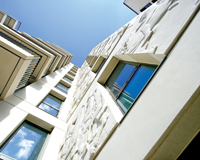Team GB’s 185 medals won in the London 2012 Olympics and Paralympics lifted the spirits of the nation over the summer, but another success is set to happen in the years to come: the legacy of Stratford being elevated into a genuinely desirable residential location.
The short term gains from the Games promised for the local lettings and sales markets, hyped-up by PR consultants and journalists alike, came to nothing.
In 2010, Telford Homes, with developments then in the pipeline at Stratford and nearby Bow and Greenwich, spoke of east London’s housing market showing “positive signs of recovery”.
However, the reality was different. Analysis by Lloyds Banking Group, released a few days before the Games began, showed average east London house prices rising 33% in the period from July 2007 (when London was awarded the Olympics) to March 2012. This outpaced UK average house price growth but masked significant local variations. Stratford itself rose only 14%, little more than half the national average.
Stories of huge rental demand turned sour by the time the cauldron was lit. Yet after the Games, a survey by Sterling, a global relocation firm, reported some agents admitting that just 2% of their rental stock had let, and many landlords had substantial void periods.
Knight Frank’s Canary Wharf office was reported to have let only 29 of its stock 60 properties during the Olympics.
But hype apart, there is a long-term legacy that will improve east London’s residential market in terms of quantity and quality of stock, and status vis-a-vis the rest of the capital.
“The real impact is at the level of regeneration,” says Yolande Barnes of Savills. “This will be felt over the next five years and the decade beyond.”
Her firm was one of many property consultancies working with the Olympic Delivery Authority to help create the 80-acre Athlete’s Village of 1,439 private and 1,379 affordable homes, and plots for another 2,500 units to be built post-Games.
These will be split into five “communities”, with schools, health centres and retail areas, in order to prevent the Olympic site becoming the kind of failed development seen in many post-Games venues worldwide.
“Without the Olympics, the Stratford City project would have been mothballed for the recession. Any housing on the site would have been watered down – small blocks without the schools and parks and definitely without the sports facilities,” Barnes claims.
“Therefore, a high-quality place has been created with high levels of amenity and public realm. It is, effectively, a new London landed estate” she adds.
The existing private homes are owned by QDD, a joint venture between Qatari Diar Real Estate Development Company and Delancey. Meanwhile, Triathlon Homes – the joint venture consortium consisting of East Thames Group and Southern Housing Group RSLs plus development investment company First Base – has purchased and will manage the existing 1,379 affordable homes.
On top of that, a joint bid by Britain’s largest housebuilder, Taylor Wimpey, and social housing landlord London & Quadrant has fended off a rival bid by Barratt Homes and East Thames RSL to build 870 homes on part of the Olympic site between the athletes’ village and the velodrome – the first of the post-Games residential contracts to be awarded.
Predictably, all the stakeholders talk up the legacy of their existing and to-be-built stock.
Pete Redfern, chief executive of Taylor Wimpey, promises “exemplar design” on the homes, most of which will be three-bedroom houses in tree-lined terrace or mews formations and aimed at family buyers, predominantly owner-occupiers.
Meanwhile, Triathlon executive director Dale Meredith says: “As the Greater London Authority will receive a share of the homes, we expect residents from across the capital to move to Stratford. This is a physical manifestation of the centre of gravity shifting eastwards, with Londoners from all quarters able to reap the benefits of the Olympics.”
Newham Council will receive 350 homes – a modest dent in its waiting list of 70,000 people – but is considering allocation ideas, including prioritising former service personnel.
The London boroughs of Barking and Dagenham, Hackney, Havering, Redbridge, Tower Hamlets and Waltham Forest are also benefitting from more than 100 social rented homes.
But these short-term benefits may be dwarfed by the new status of Stratford as a whole. “This is a fundamentally different residential offer than might have been expected had normal market conditions and no Olympics prevailed,” says Barnes. “Property values over the medium to long term have to be higher than they otherwise would have been.”
She insists the transport links in particular have “physically changed the nature of Stratford” making it a “potentially desirable residential location that perhaps wouldn’t have been considered as such before”.
Now that is a legacy.
Games Player
Robert Bartlett, chief executive of Chesterton Humberts agency, was a UK rower at the 1992 Barcelona Olympics. Despite his Olympic past, he is doubtful about the effect of the London Games.
He says the improved infrastructure will help east London but doubts its effects will stretch wider than that.
“The likelihood of any substantial ripple through the rest is limited, other than cementing the concept of London as a modern and cosmopolitan city.”
The Olympic Park Residential Offer
• Estimated 6,000 homes in total, 35% affordable, all in five neighbourhoods to be completed by 2030
• Properties from one-bedroom flats to four-bedroom townhouses
• Residential development likely to cover 67 acres adjacent to 704 acres of parkland, waterways, and nature trails
• Supporting infrastructure includes 1,800-place Chobham Academy, sponsored by Lend Lease
• Public transport access to West End in 20 minutes, St Pancras International in six minutes, Canary Wharf in 12 minutes.











